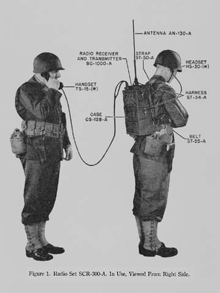SCR-300
The SCR-300 was a portable radio transceiver used by US Signal Corps in World War II. This backpack-mounted unit was the first radio to be nicknamed a "walkie talkie".[1]
History
In 1940, Motorola (then the Galvin Manufacturing Company) received a contract from the War Department to develop a portable, battery powered voice radio receiver/transmitter for field use by infantry units. The project engineering team consisted of Daniel E. Noble, who conceived of the design using frequency modulation, Henryk Magnuski who was the principal RF engineer, Marion Bond, Lloyd Morris, and Bill Vogel. The SCR-300 operated in the 40.0 to 48.0 MHz frequency range, and was channelized. Along with other mobile FM tank and artillery radios such as the SCR-508 (20.0 to 27.9 MHz) and the SCR-608 (27.0 to 38.9 MHz), the SCR-300 marked the beginning of the transition of combat-net radio from low-HF AM/CW to low-VHF FM.[2]
Although a relatively large backpack-carried radio rather than a handheld model, the SCR-300 was described in War Department Technical Manual TM-11-242 as "primarily intended as a walkie-talkie for foot combat troops", and so the term "walkie-talkie" first came into use.[3]
The final acceptance tests took place at Fort Knox, Kentucky in Spring 1942. The performance of the SCR-300 during those tests demonstrated its capacity to communicate through interference and the rugged quality of the design. Motorola was to produce nearly 50,000 of the SCR-300 units during the course of World War II.[4][5]
The SCR-300 saw action in the Pacific Theater, beginning in New Georgia in August 1943. Colonel Ankenbrandt informed General Meade that "they are exactly what is needed for front line communications in this theater". In his point of view, the main difficulty was keeping them supplied with fresh batteries.[6]
The SCR-300 saw heavy use in the Normandy invasion and the Italian campaign. It also became "key equipment" that helped deter confusion in the Battle of the Bulge.[7]
The British adopted the design of the SCR-300 for their own use from 1947 as the "Wireless Set No. 31".[8][9]
Specifications

The SCR-300 was an 18-tube battery operated radio transceiver. It used an FM transmitter section and a double superheterodyne receiver. It incorporated a squelch circuit, an automatic frequency control circuit, and a crystal controlled calibration circuit.[8][10]
- Weight:
- With battery BA-70: 38.23 lb (17.34 kg)
- With battery BA-80: 32.23 lb (14.62 kg)
- Power supply requirements:
- Filaments: 4.5 volts
- Receiver plate: 90 volts
- Transmitter plate: 60 volts (added to receiver plate voltage)
- Antenna:
- AN-130-A: Two section flexible whip, 33 inches (84 cm)
- AN-131-A: Eight section flexible whip, 10 ft 8 in (325 cm)
- Frequency range: 40 to 48 MHz (40-48 MC)
- Channel spacing: 200 kHz
- Modulation: FM voice
- Vacuum tubes:
- 3A4 (2)
- 1T4 (6)
- 1L4 (5)
- 1R5 (1)
- 1A3 (1)
- 1S5 (3)
- RF Power output: 0.3 watts
- Range: approximately 3 miles (4.8 km) (varied considerably with terrain, location of transmitter and receiver, and antenna used)
War Department Technical Manuals
- TM 11-242 for Radio Set SCR-300-A (1945)
- TM 11-983 for PP-114 Vibrator power supply (1945)
- TM 11-637 for AN/VRC-3 (1944)
See also
References
| Wikimedia Commons has media related to SCR-300. |
- Magnuski, H. S. "About the SCR-300". SCR300.org. Retrieved 2 July 2016.
- Niesel, John. "The SCR-300 Backpack Radio". warfarehistorynetwork.com. Sovereign Media. Retrieved 28 December 2018.
- J. E. Kaufmann; H. W. Kaufmann (22 September 2009). The American GI in Europe in World War II: The March to D-Day. Stackpole Books. pp. 51–. ISBN 978-0-8117-4373-0.
SCR-300 walkie talkie.
- Harry Mark Petrakis (1 January 1991). The founder's touch: the life of Paul Galvin of Motorola. Motorola University Press, J.G Ferguson Pub. Co. ISBN 978-0-89434-119-9.
- Christopher H. Sterling (2008). Military Communications: From Ancient Times to the 21st Century. ABC-CLIO. pp. 504–. ISBN 978-1-85109-732-6.
- George Raynor Thompson; Dixie R. Harris (1966). The Signal Corps: the outcome (mid-1943 through 1945). Office of the Chief of Military History, U.S. Army; [for sale by the Superintendent of Documents, U.S. Govt. Print. Off.]. pp. 667–.CS1 maint: extra punctuation (link)
- Bill Yenne, William Yenne. Secret Gear, Gadgets, and Gizmos. Zenith Imprint. pp. 32–. ISBN 978-1-61060-744-5.
- United States. War Dept (1945). Radio Set SCR-300-A, War Department Technical Manual TM 11-242. United States War Dept. Alt URL
- "SCR-300 Backpack Radio". Olive-Drab.com. Olive-Drab.com. Retrieved 2 July 2016.
- Electronics. McGraw-Hill Publishing Company. January 1945. pp. 2–.